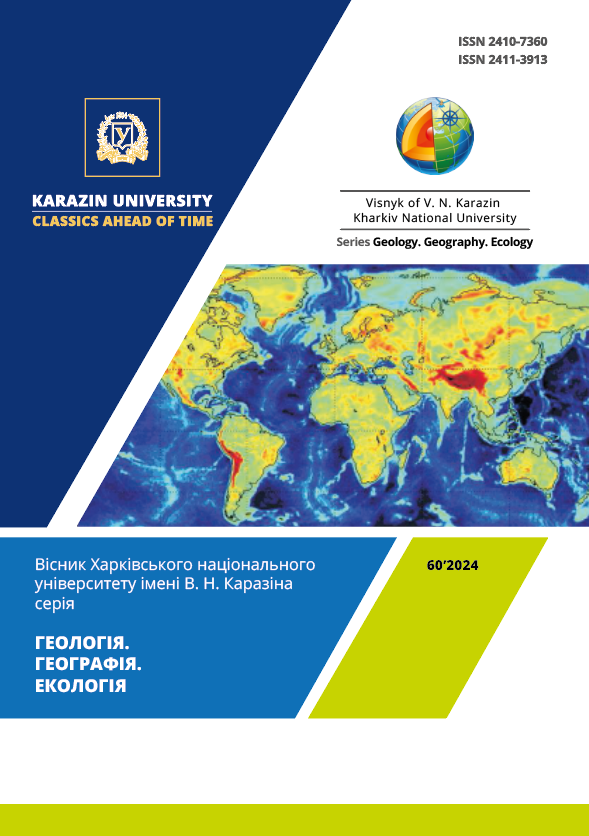Потенційні фактори регіонального розвитку небезпечних геофільтраційних процесів водокористування у басейнах підземних вод України
Анотація
Стаття присвячена потенційним факторам регіонального розвитку небезпечних геофільтраційних процесів при використанні підземних вод питної якості в Україні. Оцінено, що більшість поверхневих джерел внаслідок військових дій та техногенезу класифікуються як забруднені і брудні (IV, V клас якості), тому перехід на підземні джерела є безальтернативним. В статті виконано аналіз екологічного стану підземних вод питної якості. Обґрунтовано додаткові критерії сталого підземного господарсько-питного водопостачання. Проаналізовані дані моніторингу стану підземних водозаборів України свідчать, що їх довгострокова експлуатація супроводжується розвитком комплексу небезпечних літодинамічних процесів (НЛДП), що мають гідрогеофільтраційне походження. В статті виділено 3 провідних еколого-гідрогеологічних НЛДП: дифузія мінералізованих порових розчинів із слабопроникних шарів у експлуатаційні горизонти, фільтраційна компресія водоносних комплексів і суфозійний перенос водоносних порід з локальним зменшенням їх об’єму та, як наслідок, провальними осіданнями земної поверхні. В роботі зроблено висновок, що при будь-якій схемі формування депресійної лійки дифузійно-конвективний рух солей і мікрокомпонентів із порових розчинів слабопроникного (розділяючого або водотривкого) шару є стабільним просторово-часовим фактором впливу на гідрогеохімічний склад вод експлуатаційних водоносних горизонтів. За результатами досліджень найбільш суттєвою є фільтраційна компресія водоносного горизонту, яка спостерігається при зниженнях рівня на десятки метрів і більше при переважно піщано-пиловатому складі водонасиченого породного масиву. Крім того, в загальному плані величина осідання земної поверхні корелюється зі зниженням рівня в експлуатаційному водоносному горизонті і в більшості випадків складає 1,0-2,5 % його величини. Встановлено, що основними факторами розвитку процесів суфозії, фільтраційної компресії та деформацій земної поверхні в межах депресійної лійки за умови активного підземного водовідбору є: перше - наявність пухких порід – глин, суглинків, супісків, пісків, алевритів, лесів у геологічному розрізі зони активного водообміну (ЗАВ); друге - гранулярна неоднорідність пухких відкладів та більш щільних порід, що їх підстеляють в межах ЗАВ (або наявність в них порожнин) – пісковиків, вапняків, мергелів, черепашників, сланців; третє - вертикальна циркуляція підземних вод, що сприяє низхідній міграції пилово-глиняних часток у експлуатаційні підземні водоносні горизонти.
Завантаження
Посилання
Shestopalov V.M., Ognyanik N.S., Drobnokhod N.I. etc. (1991). Water exchange in disturbed conditions. Water exchange in the hydrogeological structures of Ukraine. K.; Naukova dumka, 528.
Shehunova S.B., Yakovlev E.O., Stadnychenko S.N., Aleseenkova M.V. (2019). Problems of nature management in the territories of liquidated salt mines in the village of Solotvino (Zakarpattya, Ukraine). Proceedings of the IV International Scientific and Practical Conference, "Actual Problems of Earth Sciences. Research of cross-border regions". 277-282.
National report on the quality of drinking water and the state of drinking water supply and drainage in Ukraine in 2022 (2023). Ministry of Regional Development of Ukraine, Kyiv, 664. [in Ukrainian]
Yakovlev E.O. (2011). Evaluation of the influence of pore solutions of regional poorly permeable layers on the formation of the quality of drinking groundwater resources. Mineral resources of Ukraine, 1, 37-46. [in Ukrainian]
Sukhorebry A. O. (2019). Pore solutions of poorly permeable rocks of platform artesian basins of Ukraine: autoref. thesis Dr. geol. Sciences: 04.00/19, 64. [in Ukrainian]
Trysnyuk V.M., Trofymchuk O.M. (2023). Modeling of the natural and technical system of water resources for the safety of critical infrastructure facilities. Subsoil use in Ukraine. Investment prospects. Materials of the Eighth International Scientific and Practical Conference (October 9-12, Lviv). 516-522. https://conf.dkz.gov.ua/files/2023_materials_net.pdf [in Ukrainian]
Myronenko V.A., Shestakov V.M. (1974). Fundamentals of hydrogeomechanics. M., "Nedra", 305.
Ognyanik N.S., Rudakov V.K., Rybyn V.F., Sytnikov A.B. (1985). Protection of groundwater in the conditions of technogenesis. K., "Higher School", 223.
Udalov I.V. (2016). Transformation of the geological environment under the influence of man-made processes (in the conditions of the North-Eastern Donbass). Kharkiv, V.N. Karazin Kharkiv National University, 176.
Yakovlev Ye., Chumachenko Ser. (2017). Ecological Threats in Donbas,Ukraine. Canada,Centre for Humanitarian Dialogue, 60.
World Bank (2006). Sustainable land management. Challenges, opportunities and trade offs. Washington D.C.: World Bank Publications.
Goldewey W.G., Wesche D., Rudolph T., Melchers C. (2014). Methods for evaluating the hydraulic barriers effects of the Escher Marl following cessation of German Hard Coal Mine. An Interdisciplanary Response to Mine Water Challenges. Proceedings of the 12th Congress of International Mine Water Association, 693-698.
Giao P.H., Phien-waj. N.A. (2014). FEM Program for the land subsidence analyses. Proc. Intl. Workshop – Hanoi Geoinginering, Vietnam National University Publishing House, 77-82.
Burenkova V. V. (1992). Assessment of Suffosion in Non-Cohesive and Graded Soils. In J. Brauns, U. Schuler, and M. Heibaum, editors, Filters in Geotechnical and Hydraulic Engineering on the First International Conference Geo-Filters, Karlsruhe, 20-22 Oktober, Rotterdam, Balkema, 357-367.
Chapuis R. P. (1992). Similarity of Internal Stability Criteria for Granular Soils. Canadian Geotechnical Journal, 29: 711-713.
Fannin R. J., Terzaghi Karl (2008). From theory to practice in geotechnical filter design. ASCE Journal of Geotechnical and Geoenvironmental Engineering, 134:267.276, Scour and Erosion, 261.
Homberg U., Binner R., and Prohaska S. (2008). Determining geometric grain structure from x-ray micro-tomograms of gradated soil. In K. J. Witt, editor, Workshop Internal Erosion, 21 of Schrifienreihe Geotechnik, Witt, K. J.
Kenney T. C. and Lau D. (1985). Internal Stability of Granular Filters. Canadian Geotechnical Journal, 22: 32-43.
Kenney T. C. and Lau D. (1986). Internal Stability of Granular Filters: Reply. Canadian Geotechnical Journal, 23: 420-423.
Kezdi А. (1979). Soil physics - selected topics. Elsevier Scientific Publishing Company, Amsterdam.
Li M. and Fannin R. J. (2008). A comparison of two criteria for internal instability of granular soils. Canadian Geotechnical Journal, 45: 303-1309.
Mehlhorn T., Prohaska S., and Slowik V. (2008). Modelling and analysis of part icle and pore structures in soils. In K. J. Witt, editor, Workshop Internal Erosion, volume 21 of Schrifienreihe Geotechnik. Witt, K. J.
Milligan V. (1986). Internal stability of granular filters: Discussion. Canadian Geotechnical Journal, 23: 414-418.
Merkblatt MSD. (2005). Standsicherheit von Dammen an Bundeswasserstral3en. Technical Report, Bundesanstalt fur Wasserbau.
Muckenthaler P. (1989). Hydraulische Sicherheit von Staudammen. PhD thesis, TU Munchen, Bericht Nr. 6.

Цю роботу ліцензовано за Міжнародня ліцензія Creative Commons Attribution 4.0.





